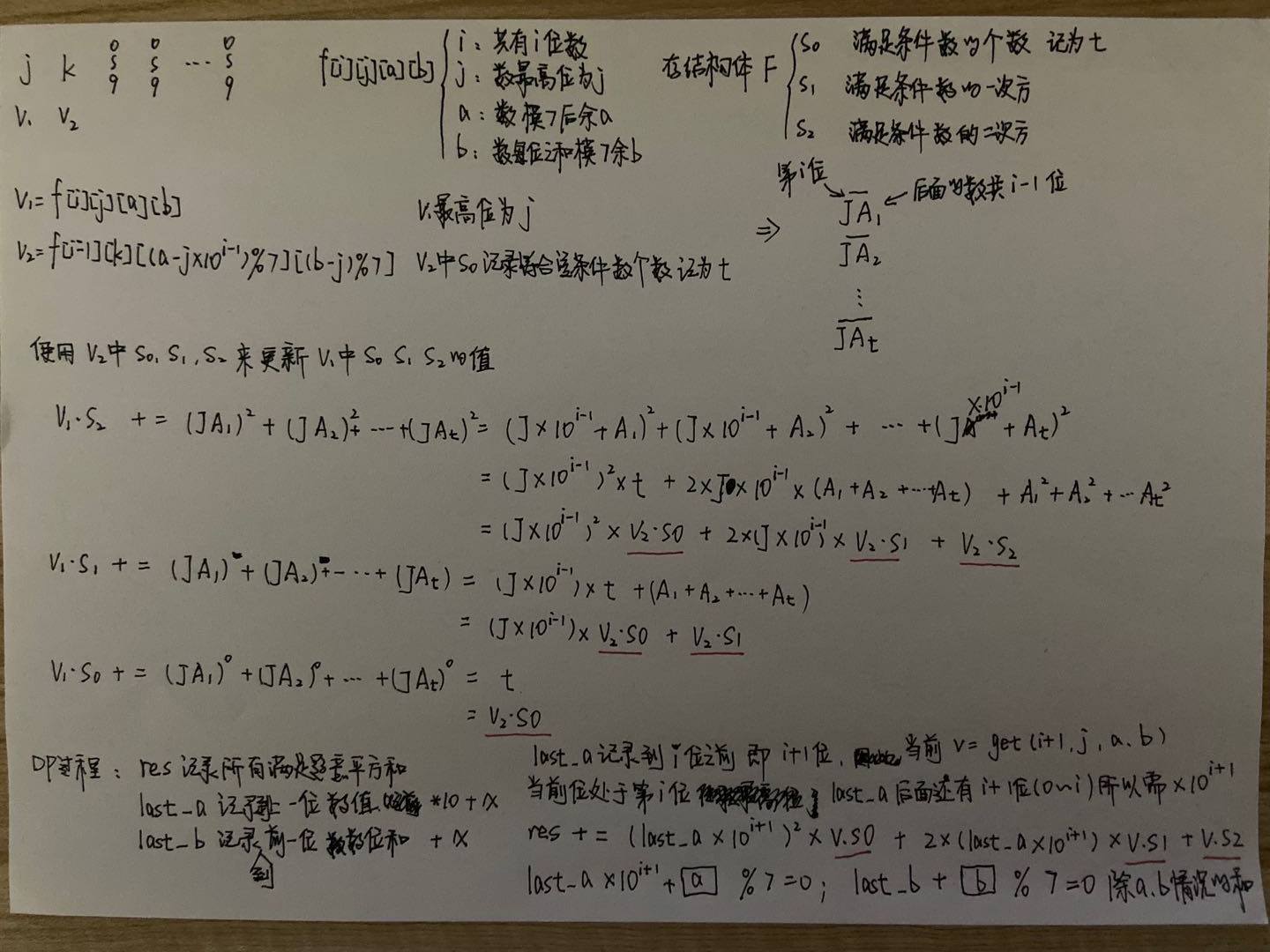便于复习

注1:% * / 的优先级高于 + -
注2:强制类型转换需要在变量上加括号例如:(int)(n % 10);
import java.util.*;
class Main{
static class F{
int s0, s1, s2;
public F(int a, int b, int c){
s0 = a;
s1 = b;
s2 = c;
}
}
private static int N = 19, P = (int) 1e9 + 7;
private static F[][][][] f;
private static long[] power10;
public static void main(String[] args){
Scanner sc = new Scanner(System.in);
int t = sc.nextInt();
init();
while(t-- > 0){
long l = sc.nextLong();
long r = sc.nextLong();
System.out.println(mod(dp(r) - dp(l-1), P));
}
}
private static int mod(long x, int y){
return (int) (x % y + y) % y;
}
private static void init(){
power10 = new long[N];
power10[0] = 1;
for(int i = 1; i < N; i++) power10[i] = power10[i-1] * 10;
f = new F[N][10][7][7];
for(int i = 0; i < N; i++){
for(int j = 0; j <= 9; j++){
for(int a = 0; a < 7; a++){
for(int b = 0; b < 7; b++){
f[i][j][a][b] = new F(0, 0, 0);
}
}
}
}
for(int j = 0; j <= 9; j++){
if(j == 7) continue;
F v = f[1][j][j % 7][j % 7];
v.s0 += 1;
v.s1 += j;
v.s2 += j * j;
//f[1][j][j % 7][j % 7] = v; !!!可以注释掉
}
for(int i = 2; i < N; i++){
for(int j = 0; j <= 9; j++){
if(j == 7) continue;
for(int a = 0; a < 7; a++){
for(int b = 0; b < 7; b++){
for(int k = 0; k <= 9; k++){
if(k == 7) continue;
F v1 = f[i][j][a][b];
F v2 = f[i - 1][k][mod(a - j * (power10[i - 1] % 7), 7)][mod(b - j, 7)];
v1.s0 = mod(v1.s0 + v2.s0, P);
v1.s1 = mod(v1.s1
+ j * (power10[i-1] % P) % P * v2.s0
+ v2.s1, P);
v1.s2 = mod(v1.s2
+ j * j * (power10[i-1] % P) % P * (power10[i-1] % P) % P * v2.s0
+ 2 * j * (power10[i-1] % P) % P * v2.s1
+ v2.s2, P);
//f[i][j][a][b] = v1; !!! 可以注释掉
}
}
}
}
}
}
private static F get(int i, int j, int a, int b){
int s0 = 0, s1 = 0, s2 = 0;
for(int x = 0; x < 7; x++){
for(int y = 0; y < 7; y++){
if(x != a && y != b){
F v = f[i][j][x][y];
s0 = (s0 + v.s0) % P;
s1 = (s1 + v.s1) % P;
s2 = (s2 + v.s2) % P;
}
}
}
return new F(s0, s1, s2);
}
private static int dp(long n){
if(n == 0) return 0;
long backup_n = n % P;
List<Integer> nums = new ArrayList<>();
while(n > 0){
nums.add((int) (n % 10));
n /= 10;
}
int res = 0;
long last_a = 0, last_b = 0;
for(int i = nums.size()-1; i >= 0; i--){
int x = nums.get(i);
for(int j = 0; j < x; j++){
if(j == 7) continue;
int a = mod(-last_a * (power10[i + 1] % 7), 7);
int b = mod(-last_b, 7);
F v = get(i + 1, j, a, b);
res = mod(res
+ (last_a % P) * (last_a % P) % P * (power10[i+1] % P) % P * (power10[i+1] % P) % P * v.s0
+ 2 * (last_a % P) * (power10[i+1] % P) % P * v.s1
+ v.s2, P);
}
if(x == 7) break;
last_a = last_a * 10 + x;
last_b = last_b + x;
if(i == 0 && last_a % 7 != 0 && last_b % 7 != 0){
res = mod(res + backup_n * backup_n % P, P);
}
}
return res;
}
}


太感谢了图片思路真的很清晰
图片好 !
图片好用心,谢谢大佬,确实有帮助,希望持续以这种形式更新,还有(少生孩子xswl)!